Vortex Structure Topology Analysis of the Transonic Rotor 37 Based on Large Eddy Simulation
Abstract
1. Introduction
2. Physical Model and Numerical Model
2.1. Physical Model
2.2. Numerical Approach and Its Validation
3. Vortex Identification Method Revisit
3.1. Brief Introduction to the Q–Criterion Vortex Identification Method
3.2. Brief Introduction to the Omega Vortex Identification Method
3.3. Brief Introduction to the Liutex Identification Method
4. Discussion
4.1. Aerodynamic Performance of the NASA Rotor 37
4.2. Vortex Structure Topology Analysis
5. Conclusions
- (1)
- Comparison and discussion of the vortex structure in the NASA rotor 37 by using three typical vortex structure identification methods, namely, the Q–criterion, the Ω, and the Liutex method, were conducted. It was found that the Q–criterion method was vulnerable to being affected by the flow with high shear deformation rates, especially in the boundary layer, such as the end–wall fields of the NASA rotor 37, where the Q values are usually high.
- (2)
- Compared with the Q–criterion method, the Ω method is insensitive to the parameter threshold value and provides a way to visualize the three–dimensional vortex structures with a higher precision of vortex identification. However, the Ω method is a scalar field and cannot provide the direction of vortices, which are very useful in analyzing the flow fields and reducing the flow losses.
- (3)
- The Liutex identification method provides a vector parameter of R. Results show that the Liutex method shows high precision in the rotor vortex visualization. It was found that the high–vorticity fields around the separation line and reattachment line were mainly composed of the Liutex component in the x–axis, the tip clearance vortices had high Liutex components in the y–axis and z axis, and the suction side corner vortex was mainly composed of the Liutex components in the y–axis and the z–axis.
Author Contributions
Funding
Data Availability Statement
Conflicts of Interest
Nomenclature
| Symbols | |||
| A | particle deformation | P | pressure |
| a | particle deformation for a specific flow condition | P0 | total pressure |
| B | vorticity intensity | q | heat flux |
| b | vorticity intensity for a specific flow condition | Q | Q–criterion function value |
| c | rotor blade chord length near the hub side | R | gas constant number |
| E | intrinsic energy | t | time |
| H0 | total enthalpy | T | temperature |
| Ma | Mach number | Tpas | time spend for per passage |
| n | design rotating speed | u | velocity |
| N | number of blades | v | vorticity |
| Greek symbols | |||
| δij | Kronecker function | ρ | flow density |
| ε | correction factor | Ω | function in Ω method |
| η | adiabatic efficiency | τij | tress tensor |
| π | total pressure ratio | ||
| Subscripts | |||
| 1 | rotor inlet | NC | near choke |
| 2 | rotor outlet | NS | near stall |
| LE | blade leading–edge | TE | blade trailing–edge |
References
- Anthony, J.S.; Jerry, R.W.; Michael, D.H.; Suder, K.L. Laser anemometer measurements in a transonic axial-flow fan rotor. NASA Sti/Recon Tech. Rep. 1989, 90, 430–437. [Google Scholar]
- Reid, L.; Moore, R.D. Design and overall performance of four highly-loaded, high speed inlet stages for an advanced, high pressure ratio core compressor; NASA TP-1337; NASA: Washington, DC, USA, 1978.
- Reid, L.; Moore, R.D. Experimental study of low aspect ratio compressor blading. J. Eng. Gas Turbines Power 1980, 102, 875–882. [Google Scholar] [CrossRef]
- Reid, L.; Moore, R.D. Performance of a Single-Stage Axial-Flow Transonic Compressor with Rotor and Stator Aspect Ratios of 1.19 and 1.26, Respectively, and with Design Pressure Ratio of 1.82; NASA TP-1338; NASA: Washington, DC, USA, 1978.
- Hah, C.; Tsung, F.L.; Loellbach, J. Comparison of two three-dimensional unsteady Navier-Stokes codes applied to a turbine stage flow analysis. JSME Int. J. Ser. B 2008, 41, 200–207. [Google Scholar] [CrossRef]
- Cinnella, P.; Michel, B. Toward improved simulation tools for compressible turbomachinery: Assessment of residual-based compact schemes for the transonic compressor NASA Rotor 37. Int. J. Comput. Fluid Dyn. 2014, 28, 31–40. [Google Scholar] [CrossRef]
- Tiow, W.T.; Zangeneh, M. Application of a three-dimensional viscous transonic inverse method to NASA rotor 67. Proc. Inst. Mech. Eng. Part A J. Power Energy 2002, 216, 243–255. [Google Scholar] [CrossRef]
- Xue, Y.; Ge, N. Engineering application of an identification method to shock-induced vortex stability in the transonic axial fan rotor. Int. J. Aerosp. Eng. 2021, 31, 6611300. [Google Scholar] [CrossRef]
- Tang, X.; Luo, J.; Liu, F. Aerodynamic shape optimization of a transonic fan by an ad-joint-response surface method. Aerosp. Sci. Technol. 2017, 68, 26–36. [Google Scholar] [CrossRef]
- Xiao, H.; Cinnella, P. Quantification of model uncertainty in RANS simulations: A review. Prog. Aerosp. Sci. 2019, 108, 1–31. [Google Scholar] [CrossRef]
- Charles, M. A Comprehensive Study of Detached-Eddy Simulation; Technische Universität Berlin: Berlin, Germany, 2009. [Google Scholar]
- Spalart, P.R.; Jou, W.; Strelets, M.; Allmaras, S.R. Comments on the feasibility of LES for wings, and on a hybrid RANS/LES approach. Adv. DNS/LES 1997, 1997, 137–147. [Google Scholar]
- Hah, C. Large eddy simulation of transonic flow field in NASA Rotor 37. In Proceedings of the 47th AIAA Aerospace Sciences Meeting including the New Horizons Forum and Aerospace Exposition, Orlando, FL, USA, 5–8 January 2009. [Google Scholar] [CrossRef]
- Hah, C.; Wennerstrom, A.J. Three-dimensional flow fields inside a transonic compressor with swept blades. J. Turbomach. 1991, 113, 241–251. [Google Scholar] [CrossRef]
- Du, J.; Lin, F.; Chen, J.Y.; Nie, C.Q.; Biela, C. Flow structures in the tip region for a transonic compressor rotor. J. Turbomach. 2013, 135, 2561–2572. [Google Scholar] [CrossRef]
- Helmholtz, H. Über Integrale der hydrodynamischen Gleichungen, welche den Wirbelbewegungen entsprechen. J. Reine Angew. Math 1858, 55, 25–55. [Google Scholar]
- Chong, M.S.; Perry, A.E.; Cantwell, B.J. A general classification of three-dimensional flow fields. Phys. Fluids A Fluid Dyn. 1990, 2, 765–777. [Google Scholar] [CrossRef]
- Hunt, J.; Wray, A.; Moin, P. Eddies, Streams, and Convergence Zones in Turbulent Flows; In Center for Turbulence Research Report CTRS88; 1988; pp. 193–208. Available online: https://ntrs.nasa.gov/citations/19890015184 (accessed on 22 December 2022).
- Zhou, J.; Adrian, R.J.; Balachandar, S.; Kendall, T.M. Mechanisms for generating coherent packets of hairpin vortices in channel flow. J. Fluid Mach. 1999, 387, 353–396. [Google Scholar] [CrossRef]
- Jeong, J.; Hussain, F. On the identification of a vortex. J. Fluid Mech. 1995, 332, 339–363. [Google Scholar] [CrossRef]
- Liu, Z.N.; Liu, Z.X.; Liu, C.Q.; McCormick, S. Multilevel methods for temporal and spatial flow transition simulation in a rough channel. Int. J. Numer. Methods Fluids 2010, 19, 23–40. [Google Scholar] [CrossRef]
- Lu, P.; Yan, Y.H.; Liu, C.Q. Numerical investigation on mechanism of multiple vortex rings formation in late boundary-layer transition. Comput. Fluids 2013, 71, 156–168. [Google Scholar] [CrossRef]
- Liu, C.Q.; Wang, Y.Q.; Yang, Y.; Duan, Z.W. New omega vortex identification method. Sci. China Phys. Mech. Astron. 2016, 59, 684711. [Google Scholar] [CrossRef]
- Liu, C.Q.; Gao, Y.S.; Tian, S.L.; Dong, X.R. Rortex a new vortex vector definition and vorticity tensor and vector decompositions. Phys. Fluids 2018, 30, 035103. [Google Scholar] [CrossRef]
- Gao, Y.S.; Liu, C.Q. Rortex and comparison with eigenvalue-based vortex identification criteria. Phys. Fluids 2018, 30, 085107. [Google Scholar] [CrossRef]
- Liu, C.Q. Rortex based velocity gradient tensor decomposition. Phys. Fluids 2019, 31, 011704. [Google Scholar] [CrossRef]
- Bai, X.R.; Cheng, H.; Ji, B.; Long, X.; Peng, X. Comparative study of different vortex identification methods in a tip-leakage cavitating flow. Ocean Eng. 2020, 207, 107373. [Google Scholar] [CrossRef]
- Wang, Y.F.; Zhang, W.H.; Cao, X.; Yang, H.K. The applicability of vortex identification methods for complex vortex structures in axial turbine rotor passages. J. Hydrodyn. 2019, 31, 700–707. [Google Scholar] [CrossRef]
- Qu, S.H.; Li, J.P.; Cheng, H.Y.; Ji, B. LES investigation on vortex dynamics of transient sheet/cloud cavitating flow using different vortex identification methods. Mod. Phys. Lett. B 2020, 34, 2150111. [Google Scholar] [CrossRef]
- Li, K.H.; Chen, X.P.; Dou, H.S.; Zhu, Z.C.; Zheng, L.L.; Luo, X.W. Study of flow instability in a miniature centrifugal pump based on energy gradient method. J. Appl. Fluid Mech. 2019, 12, 701–713. [Google Scholar] [CrossRef]
- Li, K.H.; Xu, W.Q.; Dou, H.S. Flow stability in a miniature centrifugal pump under the periodic pulse flow. Energies 2021, 14, 8838. [Google Scholar] [CrossRef]
- Zhang, W.P.; Shi, L.J.; Tang, F.P.; Sun, Z.Z.; Zhang, Y. Identification and analysis of the inlet vortex of an axial-flow pump. J. Hydrodyn. 2022, 34, 234–243. [Google Scholar] [CrossRef]
- Ren, Z.; Wang, J.; Wan, D. Investigation of the flow field of a ship in planar motion mechanism tests by the vortex identification method. J. Mar. Sci. Eng. 2020, 8, 649. [Google Scholar] [CrossRef]
- Zhang, Z.H.; Dong, S.J.; Jin, R.Z.; Dong, K.J.; Hou, L.A.; Wang, B. Vortex characteristics of a gas cyclone determined with different vortex identification methods. Powder Technol. Int. J. Sci. Technol. Wet Dry Part. Syst. 2022, 404, 117370. [Google Scholar] [CrossRef]
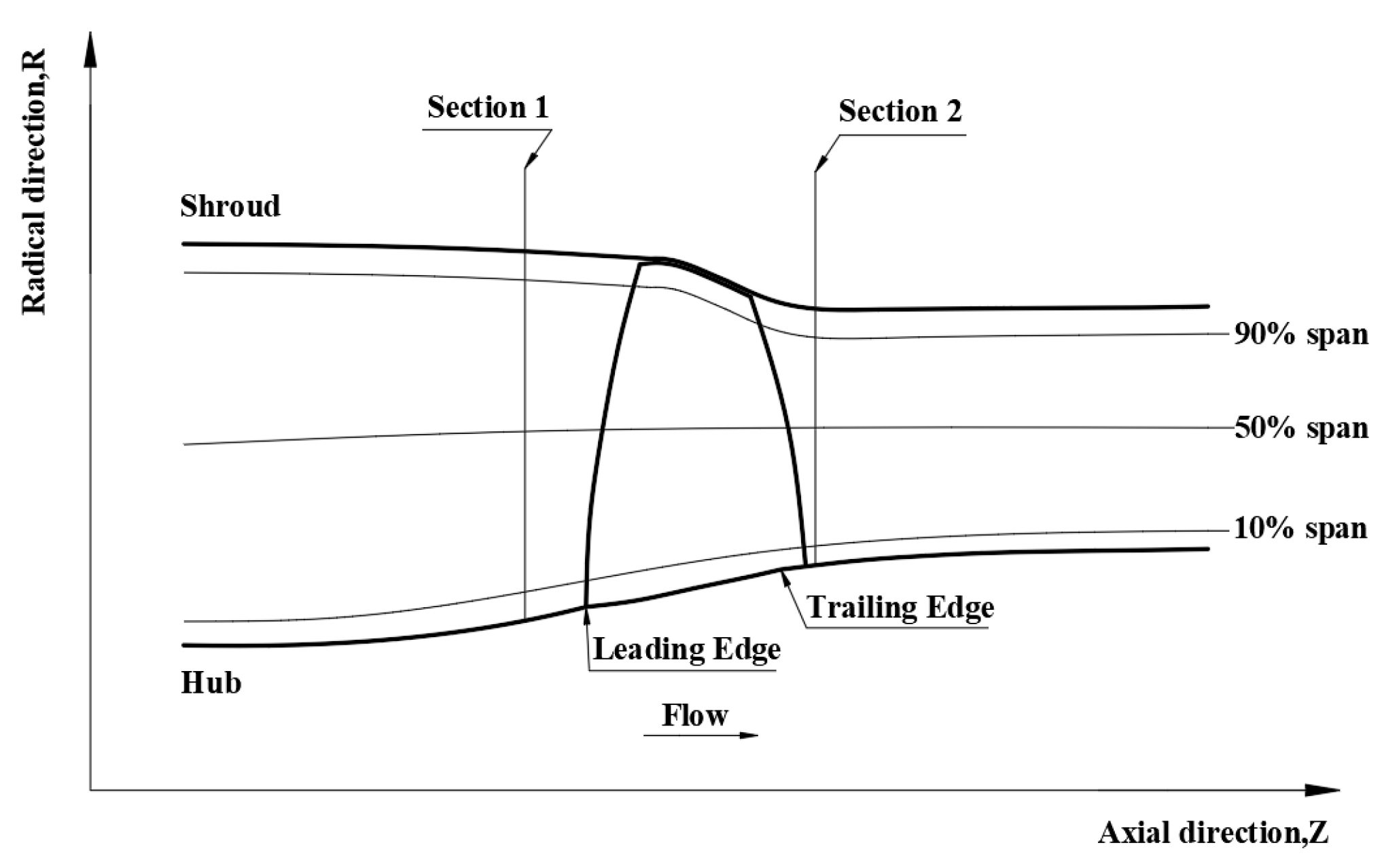

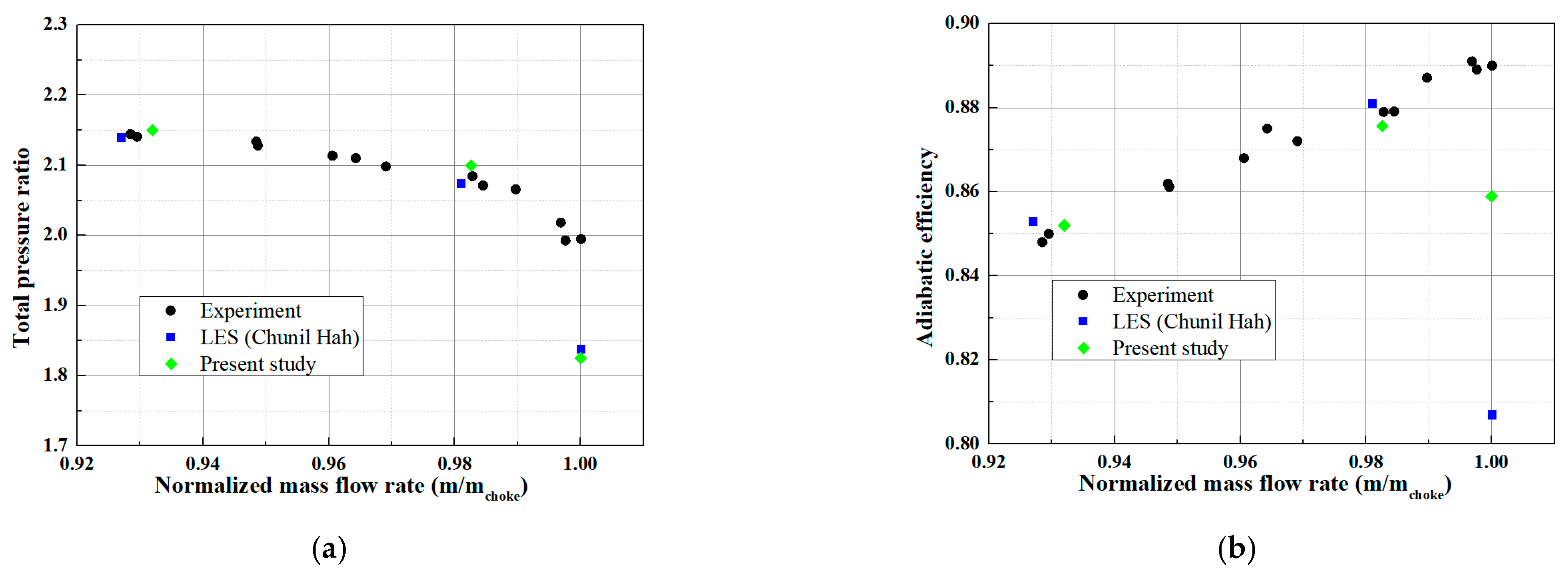

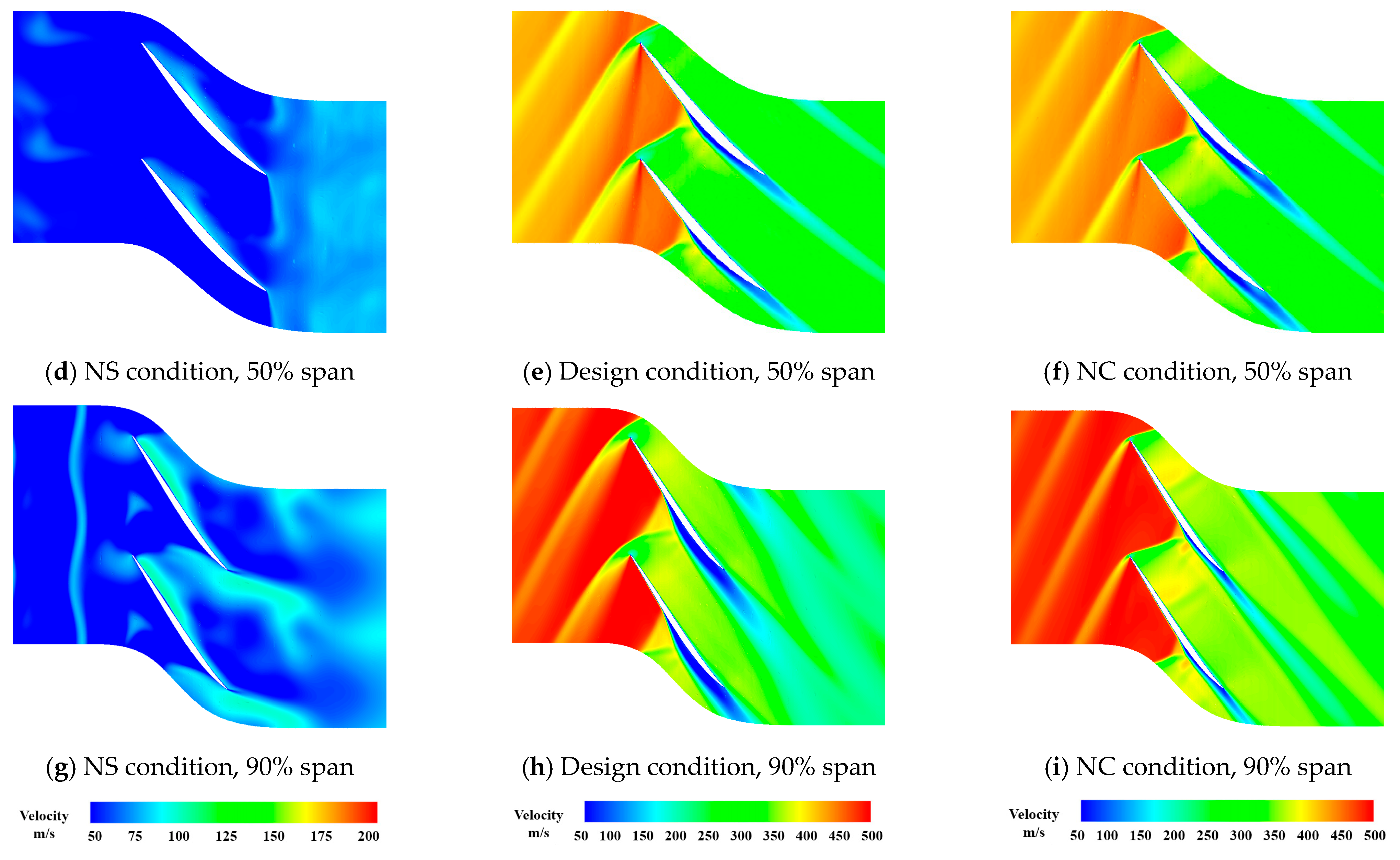
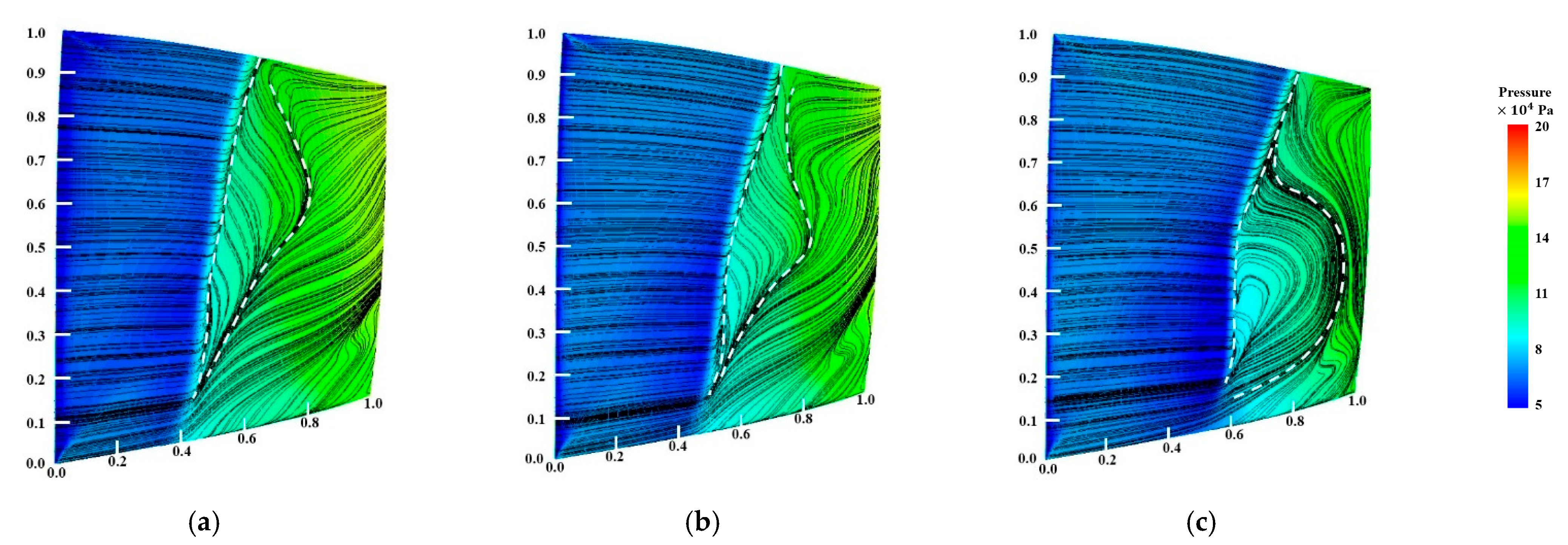
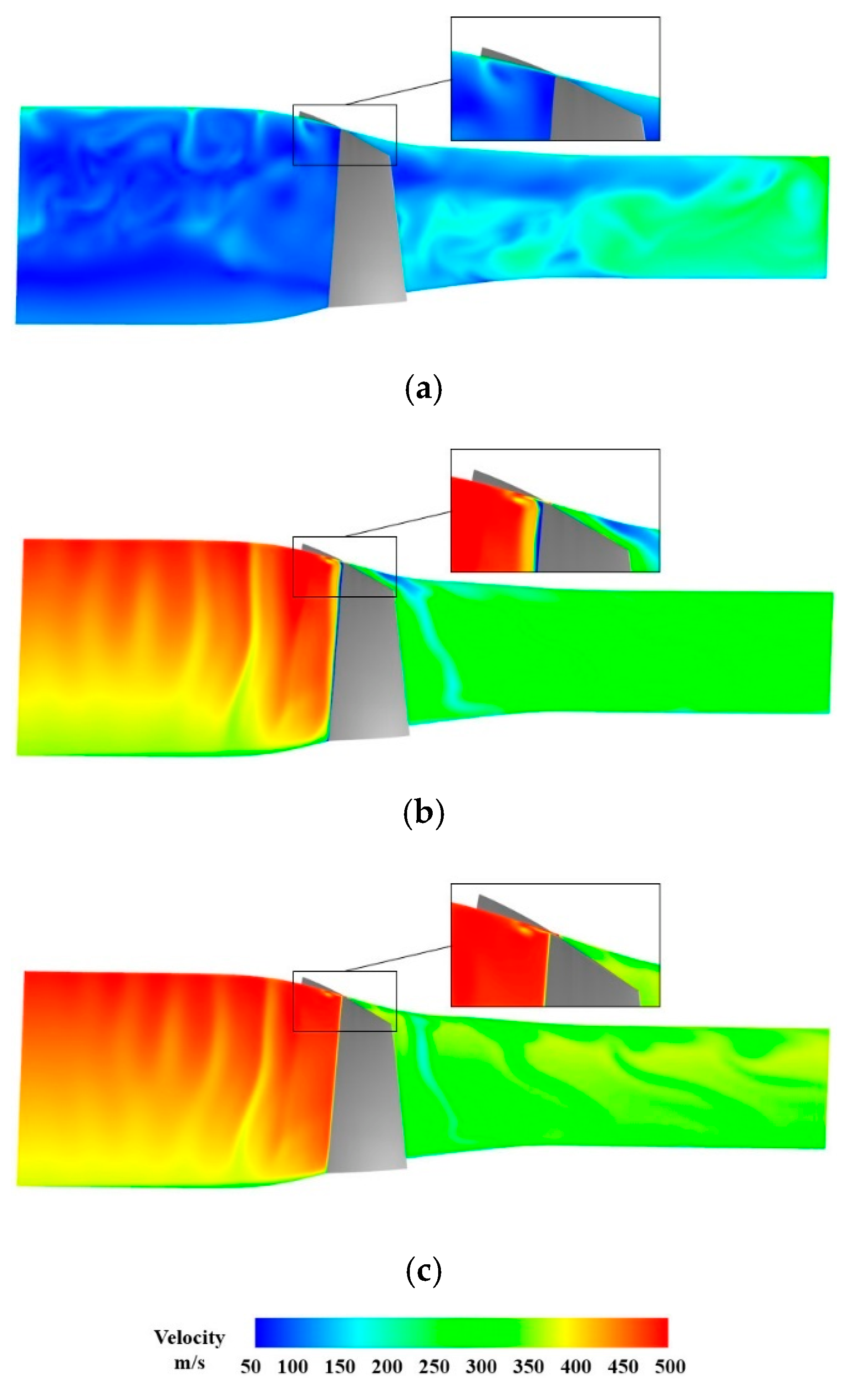
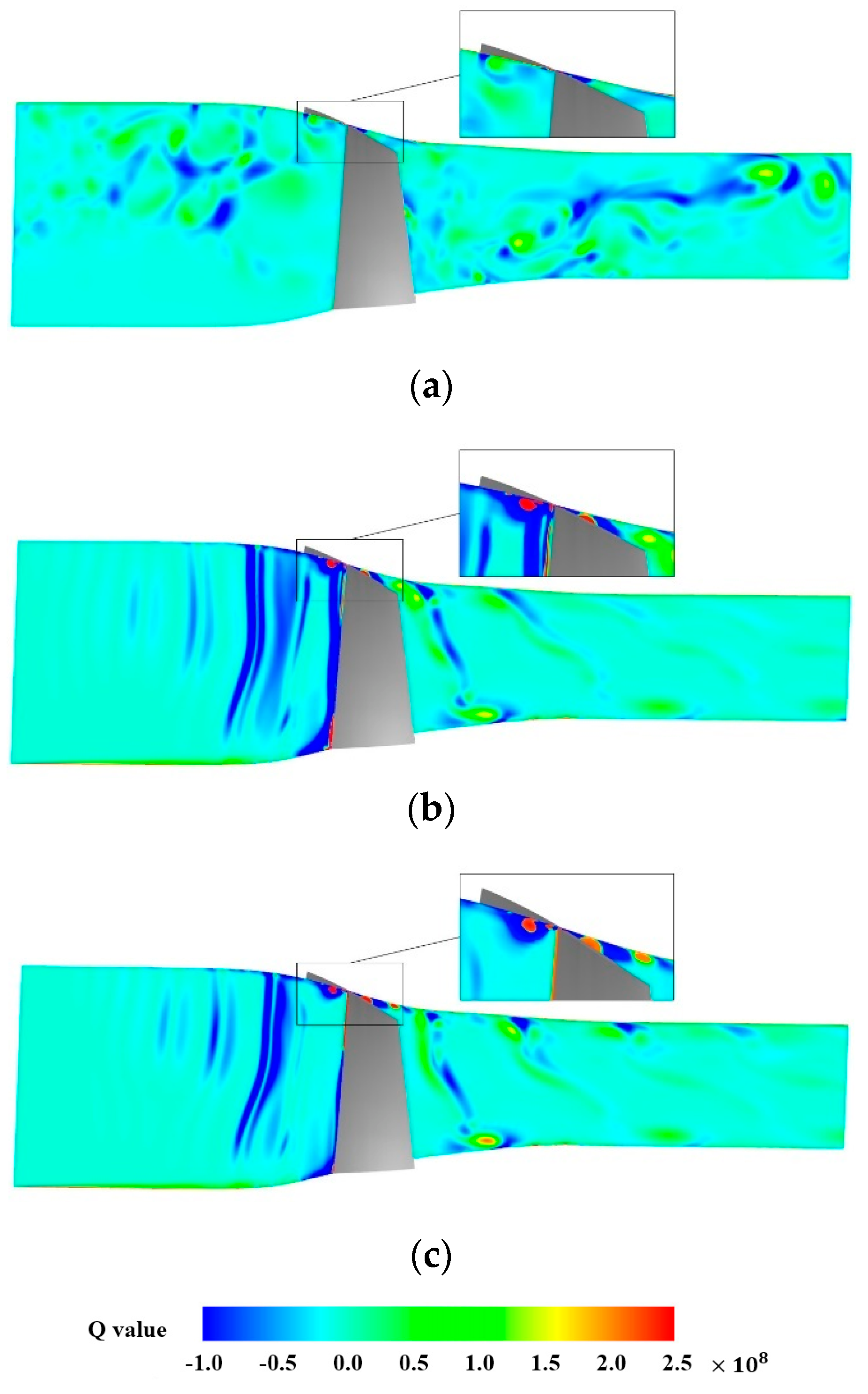
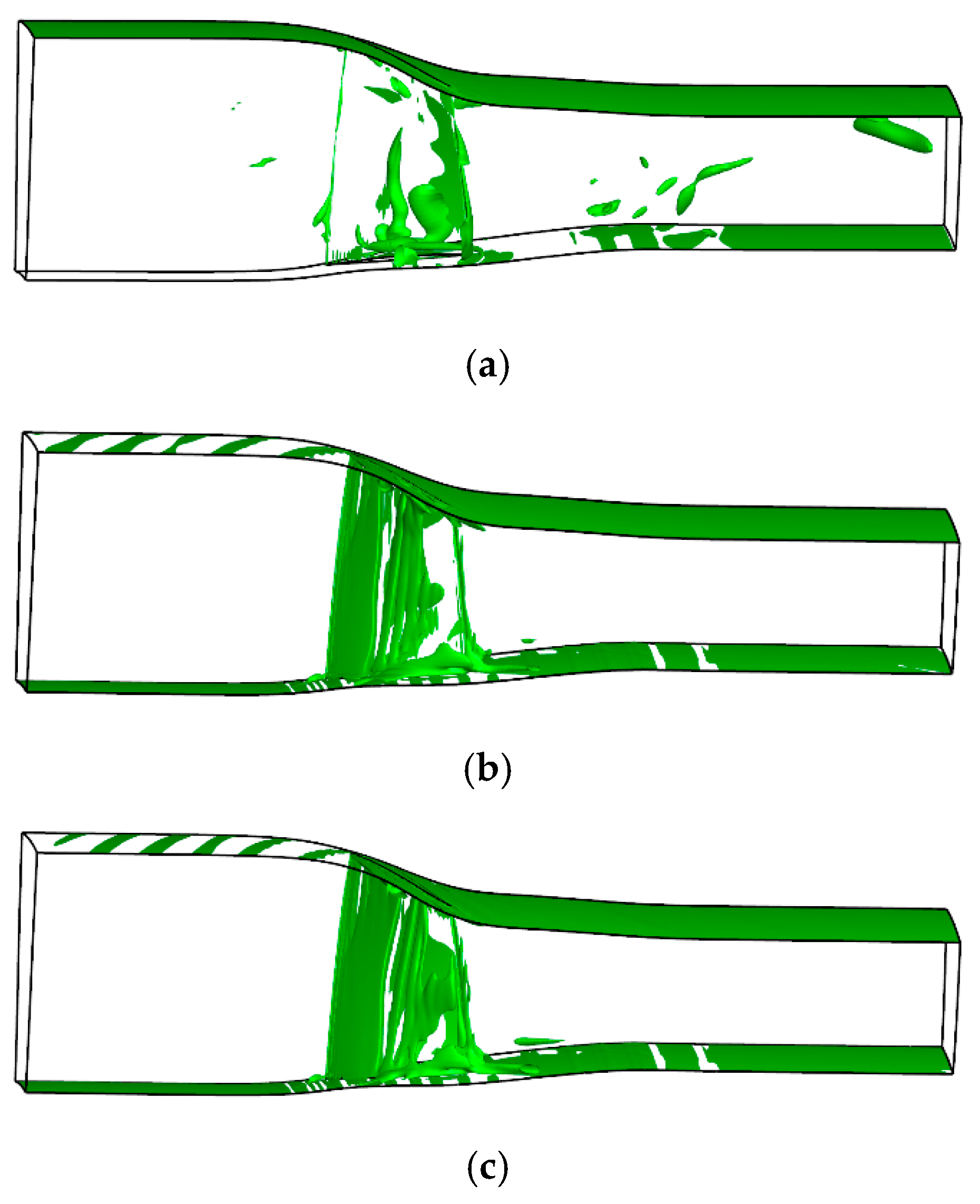
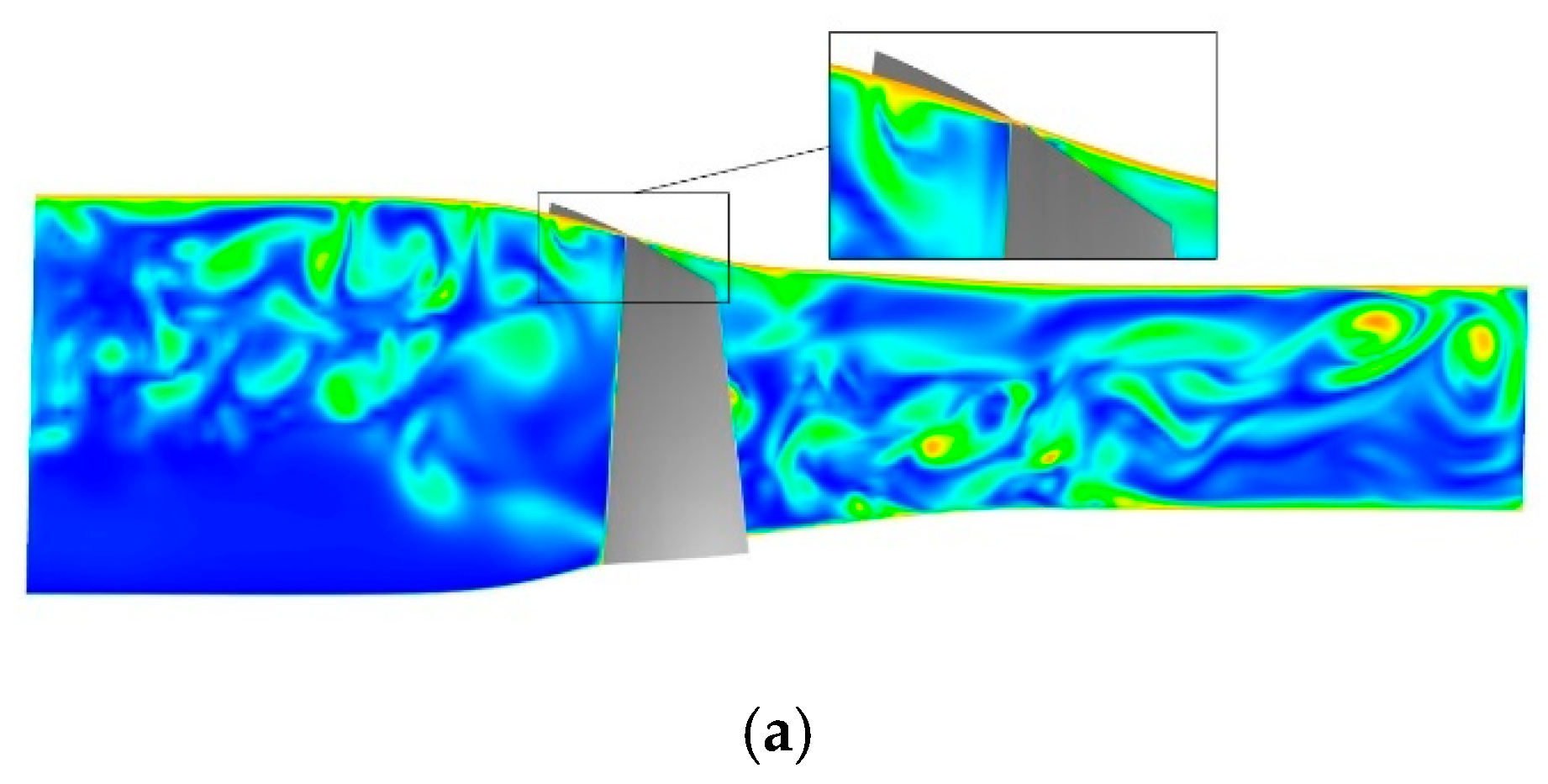
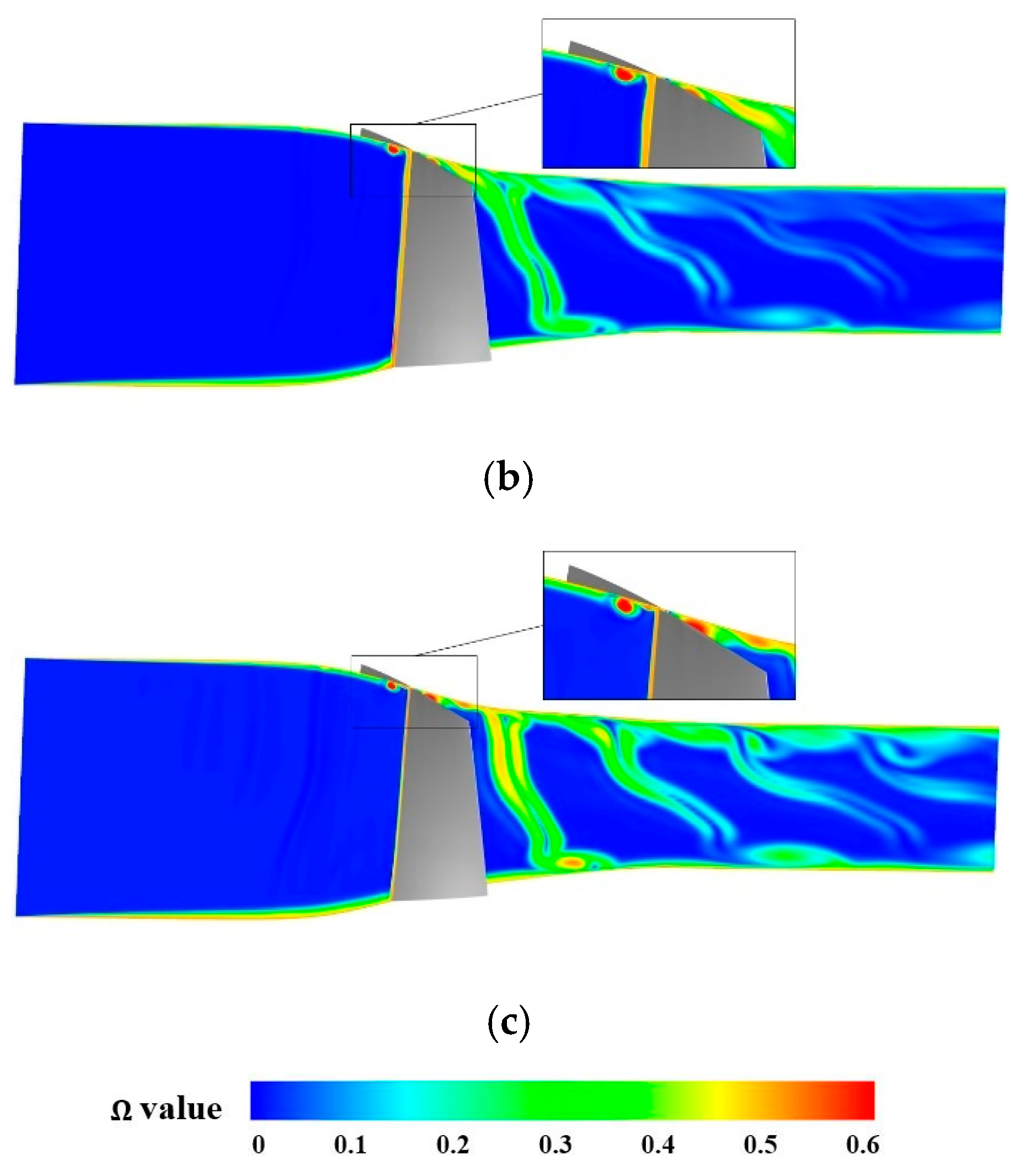
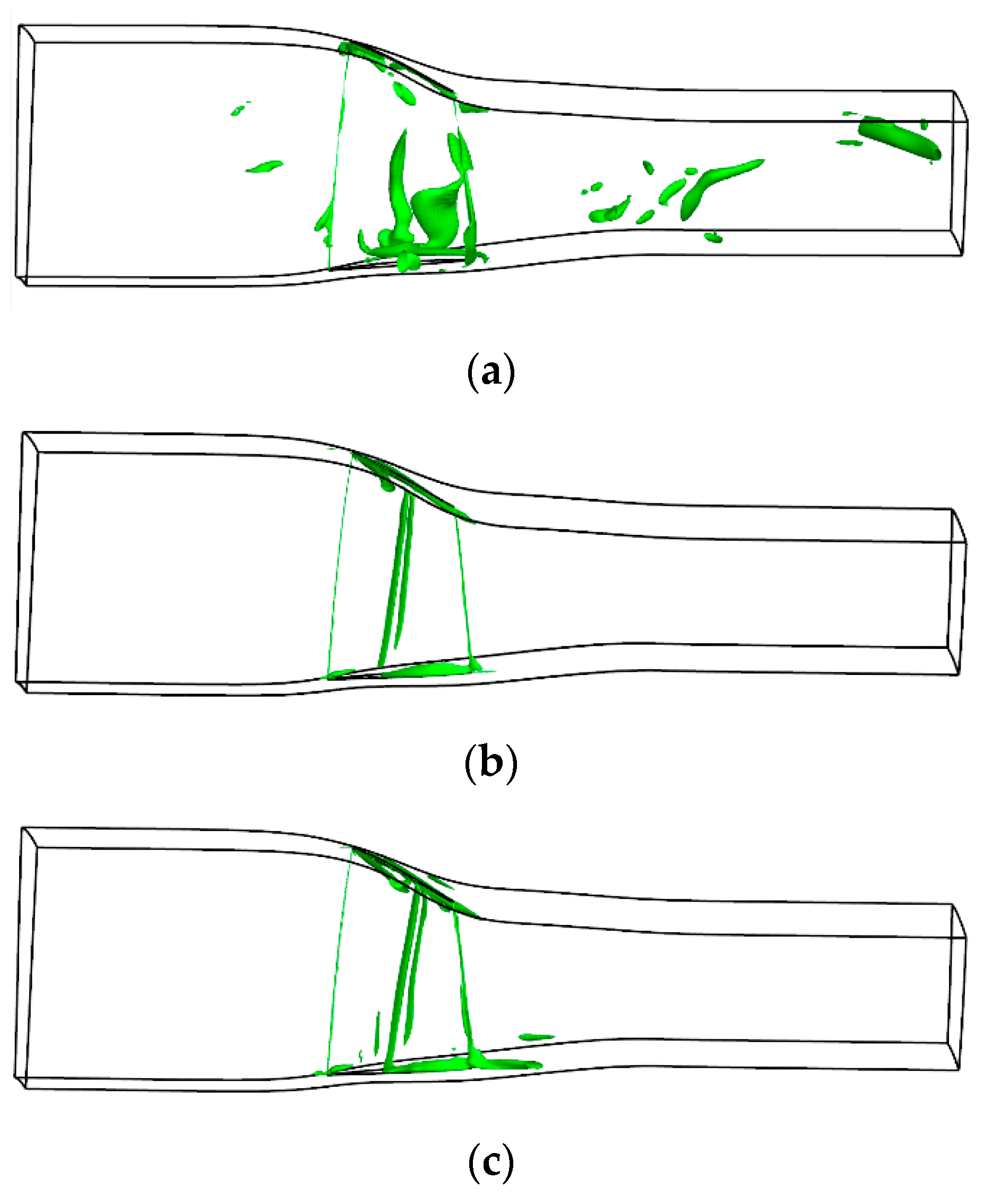
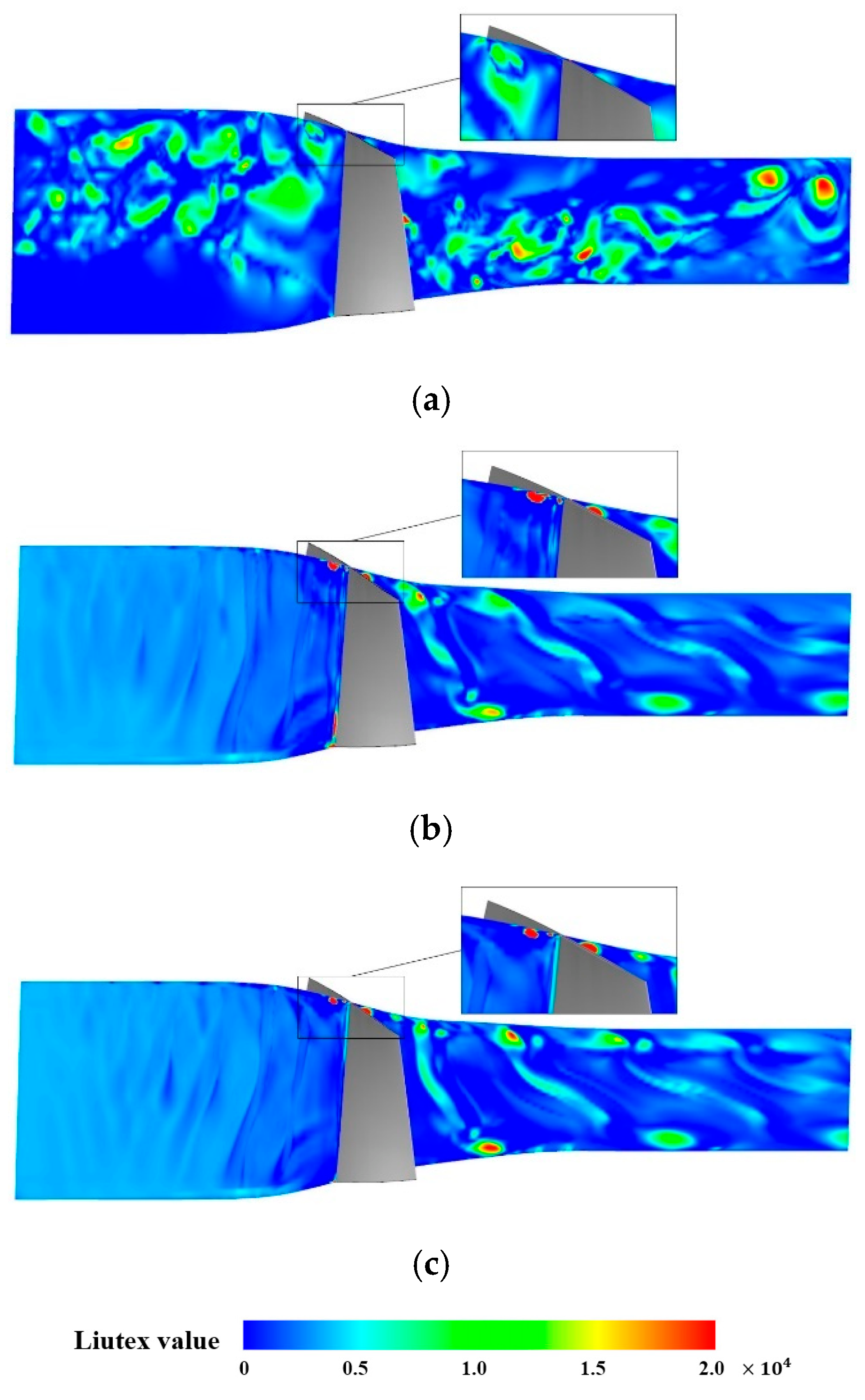
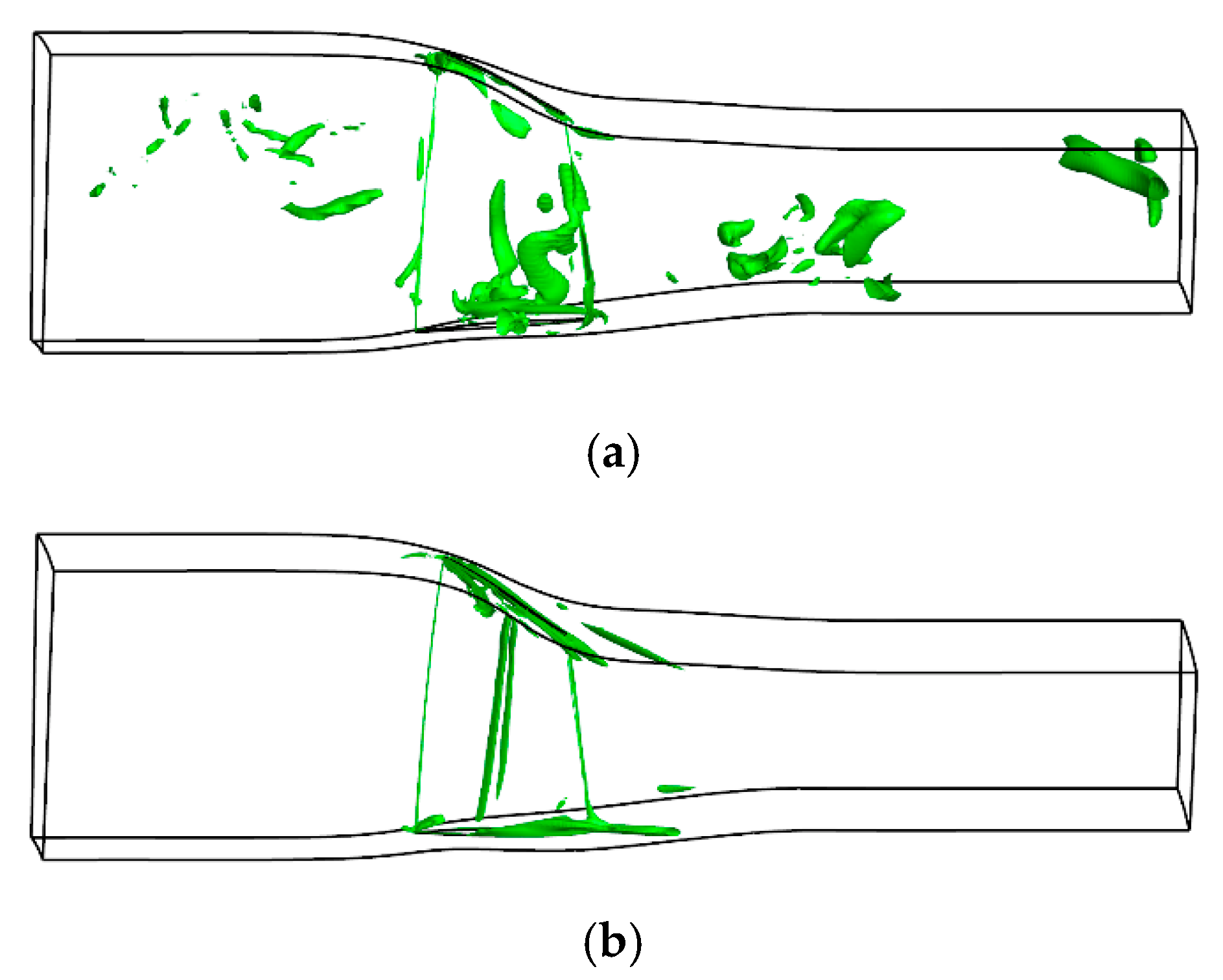
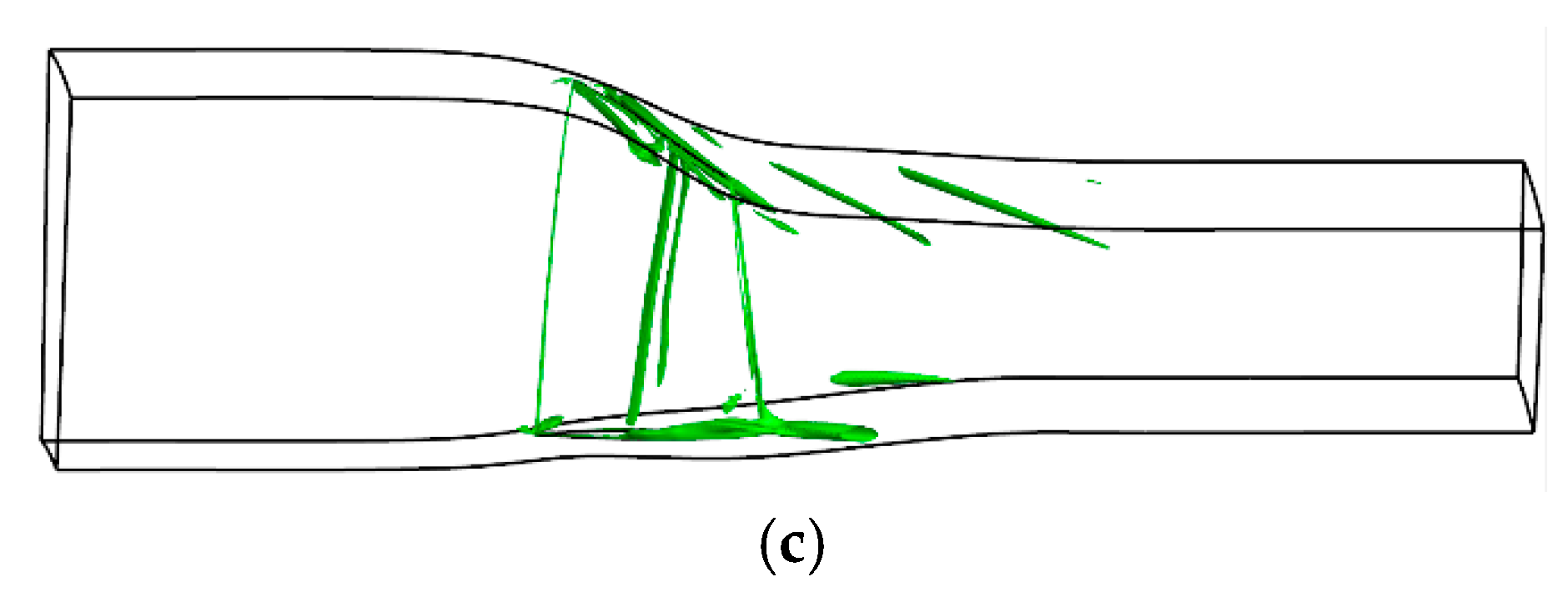
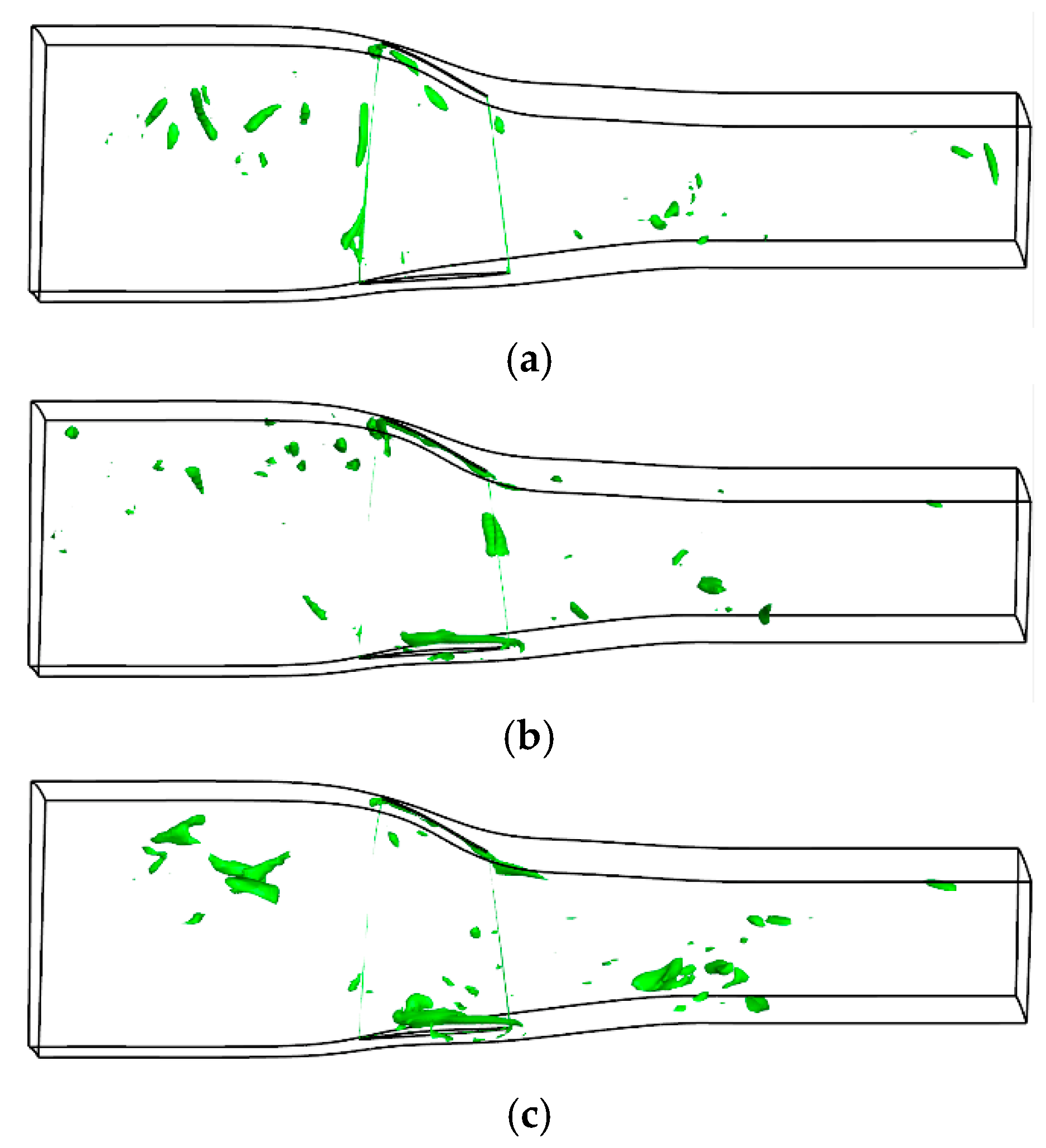
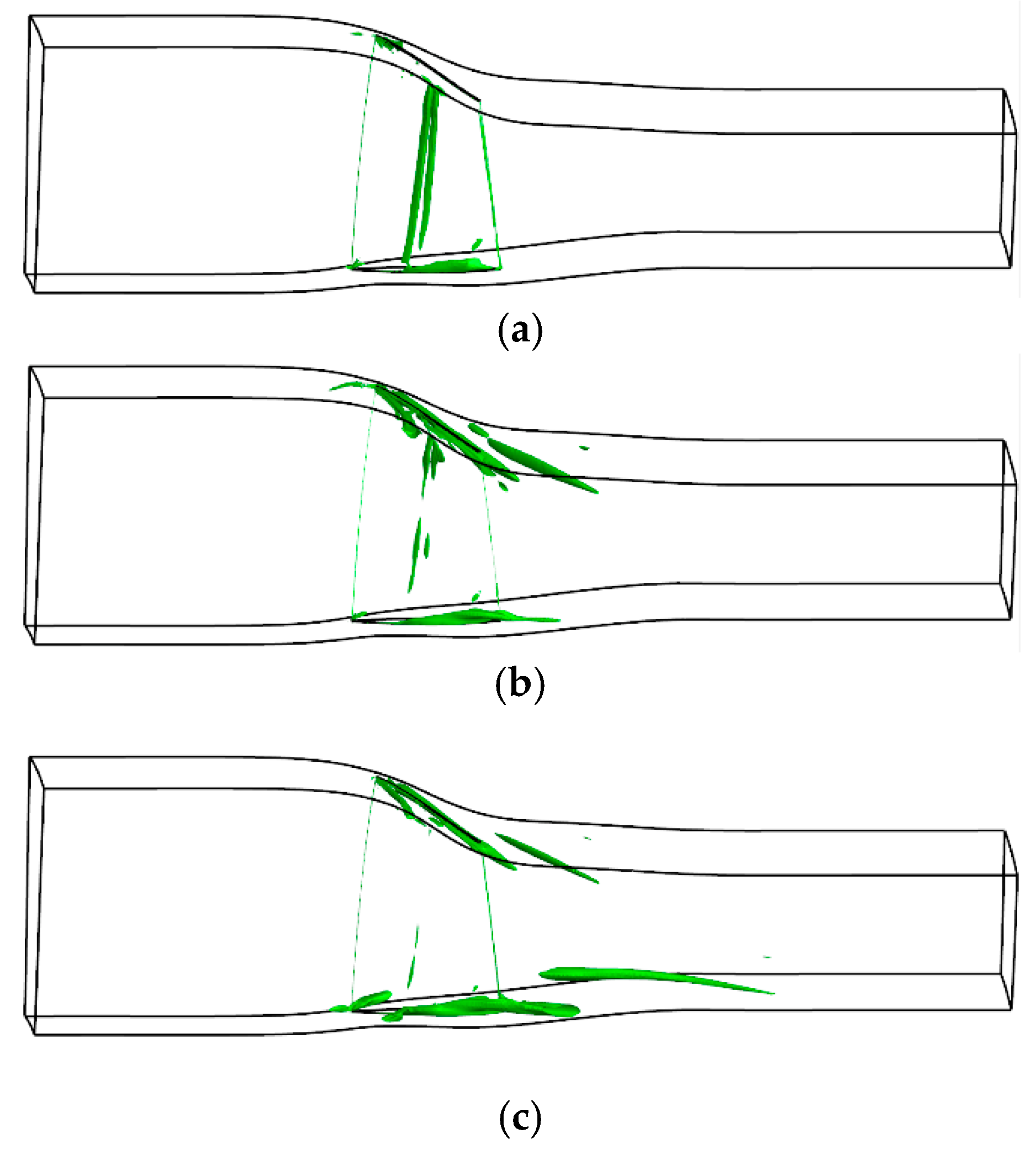
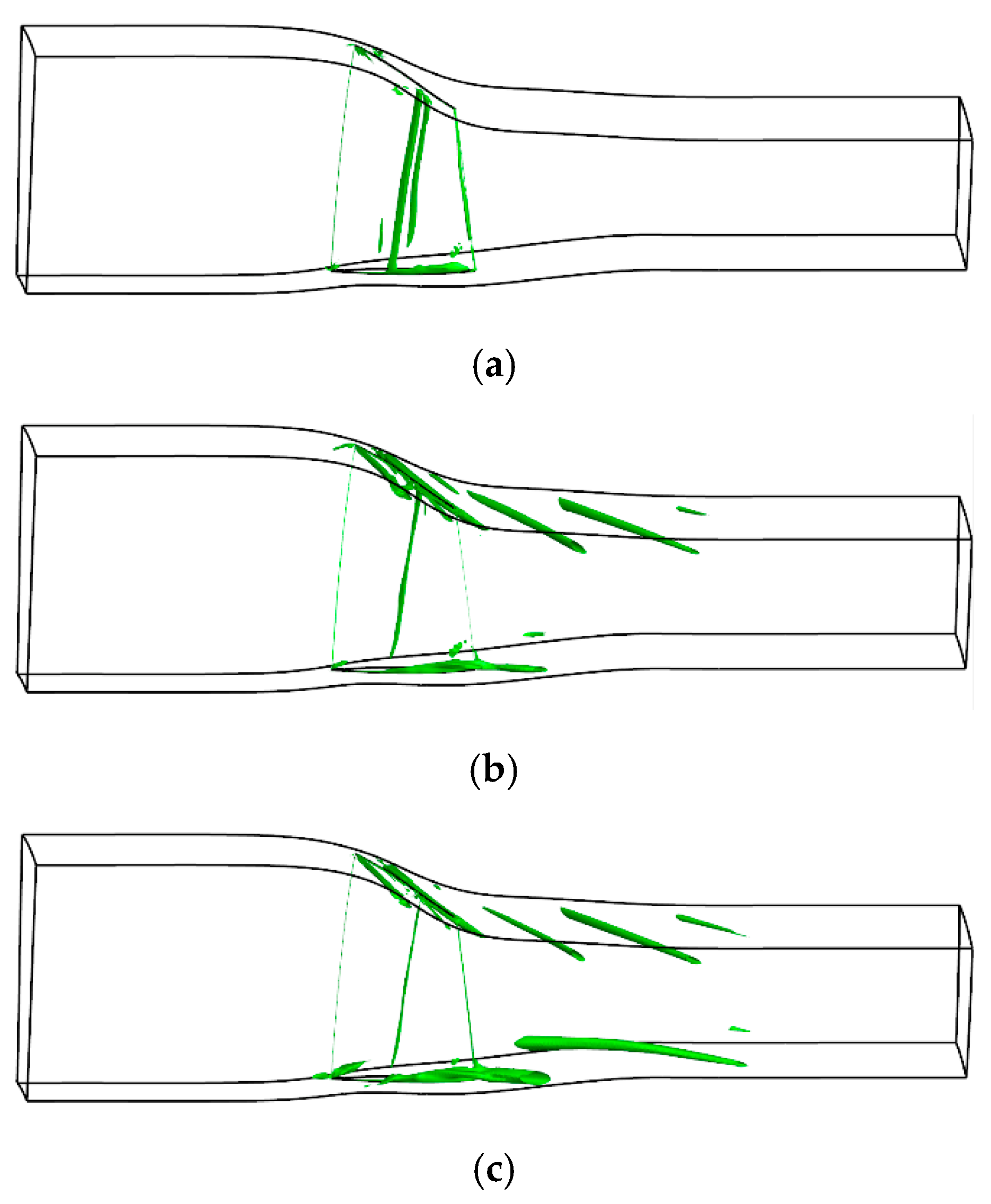
| Parameters | Design Value |
|---|---|
| Mass flow rate | 20.188 kg/s |
| Adiabatic efficiency, ηis | 0.877 |
| Design rotating speed, n | 17,188.7 rpm |
| Blades number, N | 36 |
| Rotor tip speed | 454.14 m/s |
| Total temperature ratio | 1.270 |
| Total pressure ratio, π | 2.106 |
| Blading type | Multiple circular arc |
Disclaimer/Publisher’s Note: The statements, opinions and data contained in all publications are solely those of the individual author(s) and contributor(s) and not of MDPI and/or the editor(s). MDPI and/or the editor(s) disclaim responsibility for any injury to people or property resulting from any ideas, methods, instructions or products referred to in the content. |
© 2023 by the authors. Licensee MDPI, Basel, Switzerland. This article is an open access article distributed under the terms and conditions of the Creative Commons Attribution (CC BY) license (https://creativecommons.org/licenses/by/4.0/).
Share and Cite
Li, K.; Tang, P.; Meng, F.; Guo, P.; Li, J. Vortex Structure Topology Analysis of the Transonic Rotor 37 Based on Large Eddy Simulation. Machines 2023, 11, 334. https://doi.org/10.3390/machines11030334
Li K, Tang P, Meng F, Guo P, Li J. Vortex Structure Topology Analysis of the Transonic Rotor 37 Based on Large Eddy Simulation. Machines. 2023; 11(3):334. https://doi.org/10.3390/machines11030334
Chicago/Turabian StyleLi, Kunhang, Pengbo Tang, Fanjie Meng, Penghua Guo, and Jingyin Li. 2023. "Vortex Structure Topology Analysis of the Transonic Rotor 37 Based on Large Eddy Simulation" Machines 11, no. 3: 334. https://doi.org/10.3390/machines11030334
APA StyleLi, K., Tang, P., Meng, F., Guo, P., & Li, J. (2023). Vortex Structure Topology Analysis of the Transonic Rotor 37 Based on Large Eddy Simulation. Machines, 11(3), 334. https://doi.org/10.3390/machines11030334









